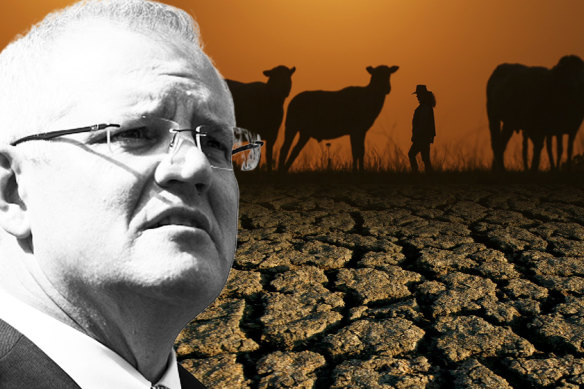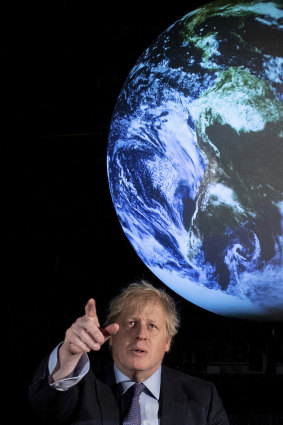This was published 2 years ago
Opinion
To power to our emissions target, we must double our energy research
By Luke Heeney and Daniel D’Hotman
Australia is increasingly isolated on climate action. If we don’t increase our ambition soon, we will feel the heat diplomatically, economically, and physically.
Our largest trading partners are making bigger, bolder and more expensive commitments to decarbonisation. With their patience for laggards running out, Australia needs to get serious about decarbonisation. Even with this budget, we have more work to do.

Australia’s emission targets have not won any plaudits from our major trading partners. Credit: Jamie Brown
Our policy of “technology not taxes” is unlikely to get us to net-zero by 2050. And if we don’t put our money where our mouth is, we probably won’t get close. Decarbonisation will not be free. “Technology not taxes″ simply means taxpayers will wear the cost of developing and commercialising low-emissions technologies.
We could develop these technologies more cheaply. An economy-wide carbon price would help to ‘pull’ technologies through and amplify the effectiveness of research and development spending. By refusing to price carbon, we make our task more difficult and more costly. So, we will need to spend even more on energy R&D to subsidise clean technologies until they reach cost parity with dirty alternatives.
The rest of the world is using technology and taxes to drive emissions reduction. You might think that, since we have done away with taxes, Australia is leading the way on public energy R&D investment.
But we’re not. In fact, we continue to lag behind our peers who are putting far more money into energy R&D. The latest International Energy Agency data from 2019 shows Australia trailing the US and UK by a factor of 10 on a relative GDP basis. Despite refinancing the Australian Renewable Energy Agency in the last budget, the UK and US each spent around four times more than us on energy R&D.
Did anything change with this budget? In good news, the government pledged around $1.2 billion over 10 years for low-emissions technology partnerships, hydrogen hubs, soil carbon sequestration, and carbon capture and storage.
There’s also around $100 million to support the development of microgrids, hydrogen-ready gas infrastructure, and other energy deployment projects. Not all of this funding will be used on energy R&D, but let’s allocate the entire $1.3 billion to be generous.
This would mean Australia’s public energy R&D annual spend has roughly doubled since 2019. But even this big increase is not sufficient. To match the UK and US, Australia would need to double our commitment once again. Such a pledge would help us to slash emissions and reach net-zero faster. But most importantly, it would bring us in line with our international peers.

We want you as a climate recruit: British PM Boris Johnson.Credit: Getty
Our allies are committing to costly emissions reduction targets that will require substantial investment beyond energy R&D.
The UK has set a target of 74 per cent below 2005 levels by 2035. The US has pledged 50 per cent by 2030. Amid this rising tide of action, Australia will be under significant pressure to commit to a more ambitious medium-term target– over and above 26-28 per cent – before the Glasgow climate conference in November.
Given that we already trail our allies on targets, anything less than parity on energy R&D spending threatens to harm our reputation even further, particularly if we don’t adopt a price on carbon. As global efforts heat up, doubling energy R&D will help to enable more rapid decarbonisation domestically. But it won’t be enough alone.
The government should look for opportunities to decarbonise through other mechanisms, such as the Emissions Reduction Fund. The existing $2 billion commitment to 2030 is not sufficient. In our budget blueprint, we argued that the government should boost its commitment to $10 billion this decade.
In addition, the feds should work more closely with the states to coordinate an orderly, reliable, and low-cost renewables transition in the National Electricity Market. Energy Minister Angus Taylor’s recent comments are welcome: “We are not going to become central planners – the market will work out what the right mix is to deliver affordable reliable energy. Our job is to work out the right signals.”
Well, a good signal to start would be new market rules that puts carbon emissions front and centre.
The combination of ambitious state renewable energy targets, increased funding for the ERF, and energy R&D spending will achieve significant carbon abatement by 2030.
Of course, this won’t be as efficient as an economy-wide price on carbon. Decarbonisation will always come at a cost to someone. We can move the cost to this person or that, but we can’t avoid it.
Regardless, time’s running out for Australia to make significant commitments. Our allies and international partners are getting impatient. The longer we wait, the more costly intervention will be. It’s time to get serious on climate action.
We can start this process by doubling public spending on energy R&D once again.
Luke Heeney is a researcher at Blueprint Institute, an independent think tank. Daniel D’Hotman is the director of research and operations at Blueprint Institute.